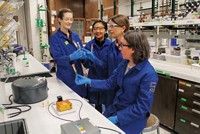Advertisement
Grab your lab coat. Let's get started
Welcome!
Welcome!
Create an account below to get 6 C&EN articles per month, receive newsletters and more - all free.
It seems this is your first time logging in online. Please enter the following information to continue.
As an ACS member you automatically get access to this site. All we need is few more details to create your reading experience.
Not you? Sign in with a different account.
Not you? Sign in with a different account.
ERROR 1
ERROR 1
ERROR 2
ERROR 2
ERROR 2
ERROR 2
ERROR 2
Password and Confirm password must match.
If you have an ACS member number, please enter it here so we can link this account to your membership. (optional)
ERROR 2
ACS values your privacy. By submitting your information, you are gaining access to C&EN and subscribing to our weekly newsletter. We use the information you provide to make your reading experience better, and we will never sell your data to third party members.
Environment
Teaching Green
Initiative encourages faster uptake of green chemistry and toxicology in the undergraduate curriculum
by Stephen K. Ritter
October 1, 2012
| A version of this story appeared in
Volume 90, Issue 40
Guiding Objectives
The Green Chemistry Commitment’s learning objectives are designed to ensure that chemistry majors have proficiency in essential green chemistry competencies.
◾ Theory: Have a working knowledge of the 12 Principles of Green Chemistry.
◾ Toxicology: Have an understanding of the principles of toxicology, the molecular mechanisms of how chemicals affect human health and the environment, and how to access the resources to identify and assess molecular hazards.
◾ Laboratory skills: Possess the ability to recognize, assess, and design greener alternative chemical products and processes.
◾ Application: Be prepared to serve society in their professional capacities as scientists through the articulation, evaluation, and employment of methods and chemicals that are benign for human health and the environment.
A group of educators in the U.S. has grown impatient with the slow headway in integrating the concepts of green chemistry and toxicology into the undergraduate chemistry curriculum. They are ready to ask academic institutions for pledges to accelerate that progress through an initiative called the Green Chemistry Commitment.
Colleges and universities that sign the commitment agree to develop goals for implementing a core set of learning objectives, says Amy S. Cannon, executive director of the nonprofit organization Beyond Benign, in Wilmington, Mass., which is leading the initiative. The objectives outline the basics of green chemistry and toxicology that students should take with them to the workplace after they graduate, Cannon says.
At the top of the list of objectives is that students should have a working knowledge of the 12 Principles of Green Chemistry. These principles, developed 15 years ago, serve as a conceptual framework to guide the design, manufacture, use, and recycling or disposal of chemical products in an economically, environmentally, and socially responsible way. Additional learning objectives include having an understanding of the molecular mechanisms of how chemicals affect human health and the environment and being prepared to communicate the benefits of green chemistry to society.
“The principles of green chemistry direct chemists toward safer, less toxic, and renewable chemistry and materials,” Cannon says. “But to advance green chemistry, a significant change must occur in how we are training the current and next generation of scientists. The Green Chemistry Commitment is an effort to unite the chemistry education community around common learning objectives that have traditionally been absent from our training as chemists.”
Many institutions have already committed significant time and financial resources to introduce green chemistry concepts into lecture courses, substitute green chemistry laboratory exercises in place of traditional labs, and use green chemistry as a research framework, Cannon says. However, a widespread, systematic approach to green chemistry education doesn’t yet exist, she notes.
For example, the American Chemical Society’s guidelines for bachelor’s degree programs provide broadly defined requirements for approved departments and graduates receiving certified degrees (C&EN, Sept. 24, page 39). Green chemistry is currently listed as a potential cross-disciplinary track that could be taught as part of the overall requirements.
Green chemistry advocates argue that green chemistry should be integrated into the foundation course work on analytical, biological, inorganic, organic, and physical chemistry, Cannon says. However, the ACS guidelines are not designed to specify the content of these courses. “Rather than waiting for a mandate to teach green chemistry principles and toxicology concepts, which might be a long time in coming, we thought we should create a mechanism for the chemistry community to commit to changing the curriculum now,” she says.
The Green Chemistry Commitment is designed to be flexible so that each institution can adopt the objectives according to its resources and capabilities, Cannon explains. For example, some departments might focus on integrating green chemistry into core lecture and lab courses, whereas others might develop separate green chemistry or toxicology courses.
Each institution’s progress in meeting the objectives will be charted in an annual report that provides an opportunity to update goals to help drive continual improvement. The reports will be evaluated by the initiative’s advisory board made up of established members of the green chemistry community, and the results will be shared with other institutions.
One university that hopes to sign on to the commitment is the University of California, Berkeley. The university is a relative newcomer to green chemistry, notes John Arnold, director of the Berkeley Center for Green Chemistry and an adviser to the Green Chemistry Commitment. UC Berkeley made its first foray into green chemistry four years ago when graduate students asked for permission to start a green chemistry and sustainable design seminar, Arnold says. The university has been rapidly expanding its efforts from there.
UC Berkeley’s green chemistry program has two focal points, he explains. At the graduate level, the department offers the seminar course and a lecture course in green chemistry. Arnold says the goal is to help the next generation of leaders in chemistry begin their careers able to include green chemistry in the courses they teach and in their research.
“At the undergraduate level, we want to weave green chemistry into the fabric of what we teach, so that undergraduate students can take these concepts with them as they go into the world as doctors, lawyers, engineers, politicians, and businesspeople,” Arnold says. To help meet that goal, UC Berkeley developed new lab experiments for its general chemistry course for nonchemistry majors, which is taken by more than 2,000 students per year—about half of all freshmen.
Green chemistry veteran James E. Hutchison of the University of Oregon is not planning on signing the commitment. He admires the initiative, but playing devil’s advocate, he raises several points of concern.
Hutchison and his Oregon colleagues have been preparing and infusing green chemistry education materials into their curriculum for 15 years. They created Greener Education Materials for Chemists, or GEMs, an interactive database of lecture course and lab materials, and the Green Chemistry Education Network, which is a social network for educators to share opportunities to develop green educational materials. In addition, they host an annual workshop for green chemistry educators.
“Hundreds of institutions have already made strides in integrating green chemistry into their teaching,” Hutchison says. The Green Chemistry Commitment has the appearance of overlooking those efforts, he points out, which could alienate some and fracture the community rather than unite it.
He is also concerned that signing a document could leave the impression that green chemistry is prescriptive and thus turn some people off. “Green chemistry wasn’t designed to be prescriptive,” Hutchison says. “It’s motivational and flexible. It provides educators with opportunities to develop courses that are the most welcoming and cutting-edge for modern undergraduates and flexible for the instructors.”
Hutchison also cautions that some aspects of the initiative are too narrow. For example, toxicology is the focus of just one of the 12 principles, he notes. Simply requiring a toxicology course might not be the best approach, he says. “It is more valuable to identify the elements of toxicology that chemists need to design greener chemicals and integrate those into the wider range of skills we need to teach in a holistic chemistry program that will allow students to excel.”
Overall, Hutchison thinks the initiative will be helpful in motivating those new to the game. But he isn’t yet convinced it will be equally valuable for those already involved.
Cannon says the Green Chemistry Commitment has evolved from its original version, following feedback from its advisory board and comments from Hutchison and others. This evolution will certainly continue, she says, as it is put into practice. Beyond Benign plans to officially launch the initiative online later this fall (www.greenchemistrycommitment.org). The initial 20 institutions—out of a planned 500— will then have several months to formulate goals before they formally sign the commitment in June 2013 at the annual Green Chemistry & Engineering Conference in Washington, D.C.





Join the conversation
Contact the reporter
Submit a Letter to the Editor for publication
Engage with us on Twitter